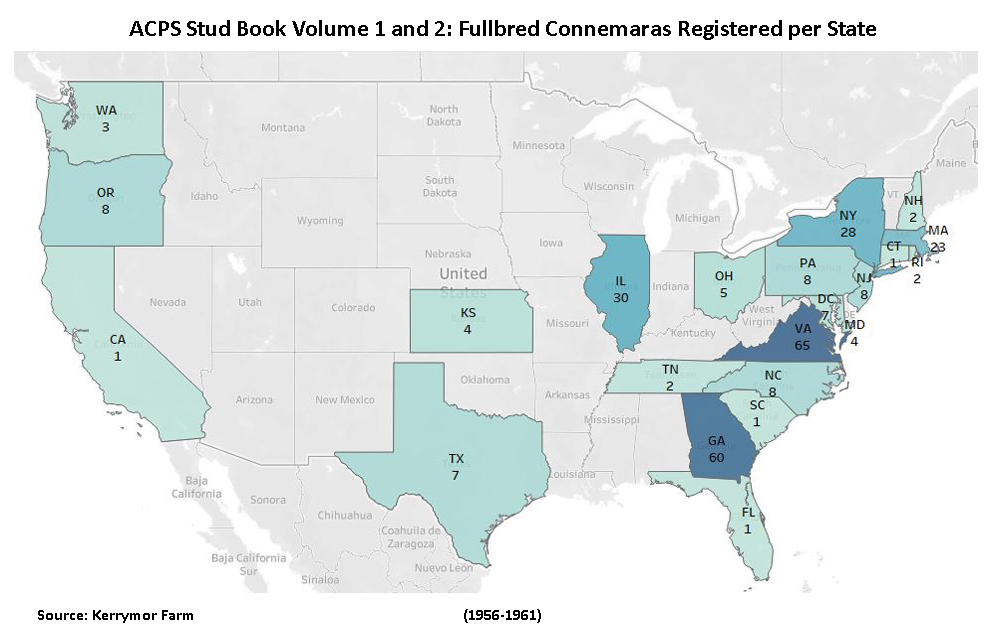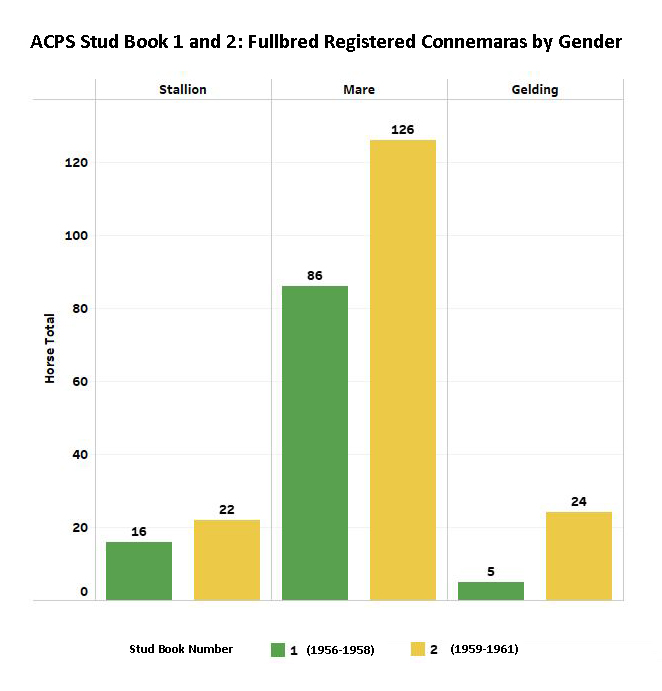ACPS Stud Book Volume 2: Connemara Ponies Expand Quickly in US
Volume 2 of the American Connemara Pony Stud Book covered the years of 1959-1961 and was published in 1962. By this point, the American Connemara Pony Society had expanded in structure and participation, and pony registrations stretched across 20 states and the District of Columbia, according to the data. Volume 1 and 2 together contained the registrations of 279 fullbred Connemaras.
ACPS Officials
The list of officials in the relatively new American Connemara Pony Society had grown to the following:
— Edward Harris Jr., of Hideaway Stables in Geneseo, New York, was president.
— Dr. Walter H. Fordham Jr. and Dr. Carl C. Johnson (of Laxfield Farm in Weston, Massachusetts) were vice presidents.
— Mrs. Bruce Read (Charlotte) of Round Robin Farm in E. Pepperell, Massachusetts, was secretary and treasurer.
— Mrs. Carl C. Johnson was assistant secretary.
— Mrs. Magruder Dent Jr. (Rosemary Romeyn Dent) of Polaris Farm in Charlottesville, Virginia, was publicity chairman.
Note that Mrs. Magruder Dent Jr. of Polaris Farm was the daughter-in-law of Mrs. Magruder Dent (Edith Baily Dent), who owned Pine Cone Farm in Southern Pines, North Carolina. Each owned and bred Connemaras.
—Mrs. Walter H. Fordham Jr. was membership chairman.
The ACPS had formed a board of 13 by this point.
Those members were:
Harry S. Middendorf as chairman, with Fordham, Rosemary Dent, and Dr. Johnson from above, plus an additional nine members: Alvin Mavis, Joseph L. Sisto, Robert H. Wright Jr., Leon Rubin, Douglas W. Chatterley, Archibald Kingsley, Mrs. Edward Harris Jr. (Jackie), Mrs. Magalen Crane, and Gen. R. C. Reynolds.
The credit for the horse breeders who shaped the early ACPS has been attributed to later breeders, when in fact the names above were the true pioneers who deserve to be honored.
Dundrum gets his due
Volume 2’s Page 3, dedicated to the Connemara pony’s origins and history, added Dundrum to the bottom of the text that had appeared in Volume 1.
Similar to Volume 1, the bottom half of the page described performance achievements.
Volume 2 added: Dundrum (sire Little Heaven, dam Evergood) is now at the peak of his career. Declared champion of the Horse of the Year Show 1961, at Wembley, England, Dundrum has defeated many famous horses, including The Rock, ridden by Olympic Gold medalist Piero D’Inzeo. He has been champion jumper at the Royal Dublin horse show for a number of years.
Secretary’s reports for 1959, 1960 and 1961
Charlotte Read included in Volume 2 her secretary’s report for 1959, 1960 and 1961. Unlike Volume 1, she excluded the names of the winners as she reported their accomplishments, instead referring to them generically as “a Connemara pony.”
She did include some general comments that have merit mentioning here.
Her 1959 report covered half a page and talked only about ponies in competition. She said the 1959 Eastern Pony Congress in Rising Sun, Maryland, brought together 30 Connemara ponies, the largest number of Connemaras ever to be shown in the United States. Even more ponies competed in the Maryland State Fair Pony Show in September 1959, she said.
Her 1960 report took the other half of the page and, again, mostly discussed Connemaras in action. She said two Virginia ponies were set to compete at the Washington International and National Horse Show that season. Read noted that a new pamphlet published in April 1960 was so popular that the supply was nearly depleted by November.
Read said paid memberships as of 1960 totaled 40, consisting of 13 life memberships and 27 annual memberships. And there were 61 owners and breeders at the time. There appeared to be crossover between the member and owner/breeder numbers.
Read’s 1961 report continued in the same vein, with Connemaras competing in a wide range of activities (a point-to-point competition, Pony Club regional rally, one-day event, and hunter shows). Of note, she said a Connemara Pony One Day Event, held in August at Hideaway Stables in New York, was the first time in history that such an event was held for Connemaras. Nine ponies competed in dressage, cross-country and stadium jumping. Also two ponies competed at the Groton Complete Test for Hunters in Massachusetts; one was Reserve Champion in open competition.
Read summarized the enthusiasm she was seeing for the breed, saying, “From all indications at present, the Connemara pony is not only here to stay but is becoming the most popular hunter pony in the country.”
Volume 2 registrations
Volume 2 registered 172 fullbred Connemaras, made up of 22 stallions, 126 mares and 24 geldings (171 appear on the map, in addition to the fullbreds from Volume 1, because one entry did not list a state). Note that these numbers incorporate a correction to Volume 2 that was made in Volume 3, changing one gelding to a stallion.
Volume 1 registered 107 fullbreds.
In Volume 2, there were 222 fullbred temporary foal certificates, consisting of 86 stallions, 103 mares, five geldings, and 28 entries that did not indicate a gender.
In the halfbred section, there were four stallions, nine mares and 19 temporary foal certificates, made up of two stallions, one gelding, and 16 mares.
Top breeders
Wright was the top breeder, registering an astounding 43 fullbred Connemaras. Thirty-nine of them had Irish temporary foal certificates or permanent Irish registration — signaling a huge influx of ponies from Ireland at the time.
Wright obtained his ponies through Stanislaus Lynch, of Ballyjamesduff in County Cavan, Ireland, who was a breeder of Connemaras and Irish Draught horses. Lynch was the first person to export large consignments to America, starting with shipping 54 Connemara ponies in 1959 to Georgia, according to The Irish Field news outlet, which published a tribute to Lynch in February 2019. Lynch also was a broadcaster at the Dublin Horse Show for many years.
Wright was located in Columbus, Georgia, and likely was the recipient of most or all of those Connemaras. The logistics of moving them must have been exhausting and expensive.
Wright’s US-born offspring started to carry his Rosehill farm name in Volume 2.
Among other leading breeders in Volume 2, Rosemary Dent (Mrs. Magruder Dent Jr. of Polaris Farm) registered seven fullbreds, while Mavis registered five under Mavis Farms and two under Alvin M. Mavis.
Dolph, of Fox Ridge Farm (the top breeder of Volume 1), registered six, as did the Harris Family of Hideaway Stables.
Magalen Crane of Whitewood Stud registered five.
Top registrations by gender
Looking at registered horses by gender, Wright led in mares and tied in top stallion registrations.
He registered 40 mares and three stallions. The stallions were Montully Man (by Tully Lad out of Toureen Pet), *Marconi (by MacDara out of Wireless Wave) and Georgia’s Mister Irish (by Cill Ciarain out of Glenoughan Grey).
Mavis also registered three stallions: Oak Hills Auratum (by Clonkeeham Auratum out of Killeaney Roan), Oak Hills Cappagh John (by Camus John out of Cappagh Queen) and Oak Hills Killeaney John (by Camus John out of Killeaney Roan). And Mavis registered four mares.
Ranking second in mares was Rosemary Dent with six.
The Harris family ranked third in mares with five, plus one stallion, Siegfried (by Tooreen Laddie out of Lorelie).
Walt Disney’s Connemara
The most famous owner in Volume 2 was Walt Disney, of Los Angeles, who registered fullbred stallion Darby O’Gill as ACPS USAS 33. The silver gray pony, born in 1957, was by Cill Ciarain out of Knockranny Beauty. The breeder was Jim Lee of Connemara, Ireland.
Consignment agent Lynch presented the 2-year-old colt to Disney in June 1959 as Disney released the film “Darby O’Gill and the Little People,” potentially at the Dublin premiere of the film, according to two sources, The Irish Field and Walt Disney Archives.
The Walt Disney Archives said the 2-year-old colt was presented to Disney in the Round Room of the Lord Mayor of Dublin’s Mansion House in Dublin. By November 1959, the colt lived at Disneyland.
Temporary Foal Certificates
Looking at the temporary foal certificates, Wright registered 65 fullbred foals in Volume 2, with 26 of those foals not permanently registered in the same volume due to the three-year time frame of the volume. Add those 26 TFCs to Wright’s 43 fullbreds, and his grand total was 69 Connemaras registered in Volume 2.
Other top breeders registering fullbred foals were Mavis with nine foals in his name, and seven under Mavis Farms, for a total of 16 (11 of those were not permanently registered in the volume, too); Crane with 14 fullbred foals (11 not permanently registered, too); and Rosemary Dent with 12 fullbred foals (eight not permanently registered, too).
Height trends
Of the 172 fullbreds registered, 139 were under 14 hands, with eight of those under 13 hands. Of those eight, one was a stallion, one a gelding, and the rest mares. Three had Irish temporary foal certificates, with the rest registered only in America. There were no notes limiting the horses’ registration or participation. It appears the minimum height restrictions seen in Volume 1 had eased, though Volume 2’s “Permanent Registration” section said correct height must be established, and the correct height was supposed to be 13 to 14.2 hands.
Of the 33 fullbreds that were 14 hands or taller, none was over 14.2 hands.
Complete registration information required
Volume 2 implemented a rule change from Volume 1, saying it would register only purebred ponies that were the offspring of registered stock. In addition, it would no longer accept Connemaras registered in Ireland automatically if the sire and dam and their parents did not appear on the registration papers. It grandfathered in ponies already in the US, as of November 1960, even if not registered by that date.
Color trends
As for coat color, 82 fullbreds were gray, and 54 were dun, with 12 falling in both categories as they were described as gray dun or slight variations. Another fullbred was white. Twenty-two were bay, eight brown, four black, six cream (one with “albino” in parentheses), zero chestnut, and three palomino, though one palomino was called “cream (palomino)” and is counted in both groups. There were 16 roans, with eight gray roans (counted in both groups), two blue roans, a red roan, a dun roan (counted in both groups), a bay roan (counted in both groups), a brownish roan (also counted with the browns) and two plain roans.
Transfers
Volume 2 included the first listings of Connemaras that transferred to new owners after registration by previous owners. There were 48 transfers across fullbreds, halfbreds and those with temporary foal certificates, broken down into nine stallions, 32 mares, and seven geldings. However, three mares (Hope Gill, Glencara Lady and Callowfeenish Lady) changed hands twice. So the total Connemaras involved was 45 and the total mares was 29. Virginia accounted for the most new owners, with 12, followed by Maryland (seven) and North Carolina (six). William F. Lovell, MD, transferred the most Connemaras (six) to his name, while Magalen Crane transferred four to her name.
—–
Read our summaries of other ACPS Stud Book Volumes
—–
Below are the Volume 2 images of Connemaras An Tostal, Erin Heaven, Gael Linn, Laxfield Gil Tully, Marconi, Tully N*****, and Whitewood Muffin.








